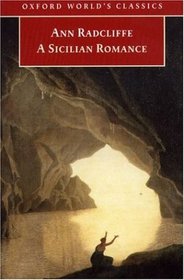I have read this book and The Mysteries of Udolpho. I honestly liked this book better than Udolpho. I got more immersed in the story and for me it was truly suspenseful and truly enjoyable. I'm going to read either The Romance of the Forest or the Italian next.
Robert M. (shotokanchef) reviewed A Sicilian Romance (Oxford World's Classics) on + 813 more book reviews
Set in Sicily, the second of her set of gothic novels revolves around (where else) a gloomy castle that is half-deserted and haunted, replete with endless locked doors and eerie halls, most of which lead nowhere but more of the same. Well, except for the crumbling, unlit tower in which the intruder experiences a circumstance that will be relived 123 years later by Stevensons David Balfour (Catriona aka David Balfour). These eventually give way to caverns, replete with locked doors, or course. And, in traversing either, one always seems to descendin both directions. The maze of passages is the maze of vice; one leads to another.
The author constantly names characters about whom the reader has no inkling whatever, nor does she provide any immediate explanation as to their connection to the story. She fails to differentiate between an abbey, or monastery or friary, and a novitiate, or convent: often having them cohabited. She also indicates respect for the sanctity of the confessional, yet declares that one friar, seeming properly, has discloses a penitents confession to his superior.
The theme of all of this? It is very much similar to that of The Italian, or I am more correct to say that the theme of The Italian is quite similar to that of this novel. The Mediterranean scene will be repeated in her later novels. As in many gothic novels, there is the overbearing family, partly the result of a second marriage: the marquis (a Simon Legree type) bent upon forcing a daughter into an unwanted marriage to an elder duke (a Snidely Whiplash); the step-mother who is envious of the daughters enamouration with a young Count; the purported death of the count at the hands of her father (Yes! 76 pages later he turns up as good as new.); the daughters escape and flight; her pursuit by father and suitor; her refuge in an abbey. Its decision time! The veil or the duke? The lady or the tiger as it were. At the abbey the daughter befriends a nun who is close to being her doppelganger; whose experience is closely intertwined with the daughter. The nun and her former suitor are in the same abbey; a nun and a friar separated forever by their separate vows. (A similar situation occurs some 70 years later in Reades The Cloister and the Hearth.) Her decision to take the vows is abated; she escapes and the chase begins anew. So far (I have omitted several), we have every possible coincidental interactive event possible. Despite dungeons and an endless number of locked doors (It was evidently quite easy to escape from medieval castles.), bandetti, multiple pursuers, storms at sea, and shipwrecks that read like The Perils of Paulinewell, read the book. It is a struggle between the landed gentry and the church: between good and evil.
The author constantly names characters about whom the reader has no inkling whatever, nor does she provide any immediate explanation as to their connection to the story. She fails to differentiate between an abbey, or monastery or friary, and a novitiate, or convent: often having them cohabited. She also indicates respect for the sanctity of the confessional, yet declares that one friar, seeming properly, has discloses a penitents confession to his superior.
The theme of all of this? It is very much similar to that of The Italian, or I am more correct to say that the theme of The Italian is quite similar to that of this novel. The Mediterranean scene will be repeated in her later novels. As in many gothic novels, there is the overbearing family, partly the result of a second marriage: the marquis (a Simon Legree type) bent upon forcing a daughter into an unwanted marriage to an elder duke (a Snidely Whiplash); the step-mother who is envious of the daughters enamouration with a young Count; the purported death of the count at the hands of her father (Yes! 76 pages later he turns up as good as new.); the daughters escape and flight; her pursuit by father and suitor; her refuge in an abbey. Its decision time! The veil or the duke? The lady or the tiger as it were. At the abbey the daughter befriends a nun who is close to being her doppelganger; whose experience is closely intertwined with the daughter. The nun and her former suitor are in the same abbey; a nun and a friar separated forever by their separate vows. (A similar situation occurs some 70 years later in Reades The Cloister and the Hearth.) Her decision to take the vows is abated; she escapes and the chase begins anew. So far (I have omitted several), we have every possible coincidental interactive event possible. Despite dungeons and an endless number of locked doors (It was evidently quite easy to escape from medieval castles.), bandetti, multiple pursuers, storms at sea, and shipwrecks that read like The Perils of Paulinewell, read the book. It is a struggle between the landed gentry and the church: between good and evil.
This early novel explores the cavernous landscapes and labyrinthine passages of Sicily's castles and convents to reveal the shameful secrets of its all-powerful aristocracy. Julia and Emilia Mazzini live secluded in in an ancient mansion near the straits of Messina. After their father's return to the island a neglected part of the house is haunted by mysterious sights and sounds. When revelation of the origin of these hauntings finally comes, it forces the heroines to challenge the united forces of religious and patriarchal authority.




